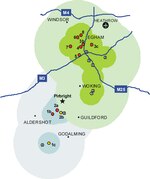Ash to Brookwood Heaths

Ash to Brookwood Heaths is a 1,576.3-hectare (3,895-acre) biological Site of Special Scientific Interest west of Guildford in Surrey. It is a Nature Conservation Review site, Grade I. It is part of the Thames Basin Heaths Special Protection Area and the Thursley, Ash, Pirbright and Chobham Special Area of Conservation. An area of 1,392 hectares (3,440 acres) is managed as a nature reserve by the Surrey Wildlife Trust.This site has dry heathland, wet heath and bog. Large areas have been protected from development because they are army training ranges. The site is important for mosses and liverworts and there are nationally important populations of nightjars, woodlarks, Dartford warblers and hobbies.
Excerpt from the Wikipedia article Ash to Brookwood Heaths (License: CC BY-SA 3.0, Authors, Images).Ash to Brookwood Heaths
Pirbright Road,
Geographical coordinates (GPS) Address Nearby Places Show on map
Geographical coordinates (GPS)
| Latitude | Longitude |
|---|---|
| N 51.277 ° | E -0.687 ° |
Address
Ash, Stoney Castle and Henley Park Ranges
Pirbright Road
GU3 2AQ
England, United Kingdom
Open on Google Maps








